Ride the Altai Mountains and visit the spectacular Eagle Festival
This trip follows a similar plan to our Altai Mountain Horse Trek, but with the added bonus of the famous two-day Eagle Festival
This trip follows a similar plan to our Altai Mountain Horse Trek, but with the added bonus of the famous two-day Eagle Festival
Including current availability
Update 17th October 2025: Accepting bookings now.
A provincial alternative to the main Ulgii eagle festival, for those who prefer smaller crowds. All the chaos and spectacle of the bigger festival, but you can get closer to the action.
If you're not madly keen on the idea of a festival, but would still like to experience the eagle hunting culture, join one of our earlier Altai Mountain treks. These trips include an informal half-day mini-festival, where our eagle hunter friends will introduce you to their eagles and demonstrate traditional horse games. Participation is encouraged!
To see eagles hunting for real, you will need to come in winter. That's a whole other type of trip, which we would be very happy to talk to you about.
If you would like to see one of the eagle festivals, but don't want to ride in the Altai Mountains, we may be able to help with a tailored trip. Ask us about options.
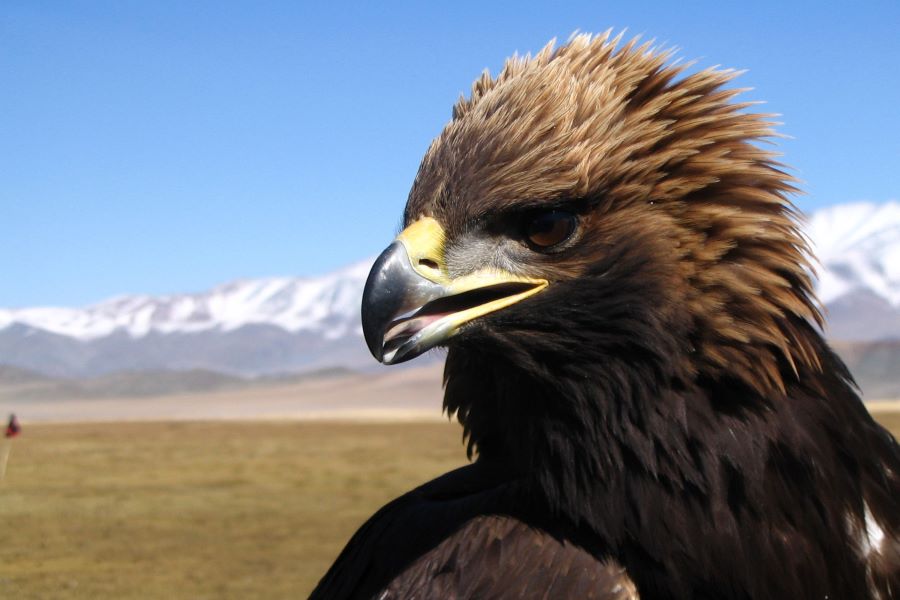
Hunting with eagles has long been a tradition amongst the Kazakh minority in the west of Mongolia, and since 1999 it has been celebrated at the annual Eagle Festival in Ulgii. Several smaller festivals have also sprung up over the years. These celebrations of eagle hunting and horsemanship really are amongst the world's great cultural festivals. If you think you've seen some strange and interesting festivals elsewhere, this is sure to impress even the most jaded festival-goer. In the words of Emily from New Zealand:
"There's not much to be said about the Eagle Festival except that it was undoubtedly the best festival in the history of the universe and two of the best days of my time in Mongolia. Awesome, awesome, awesome..."
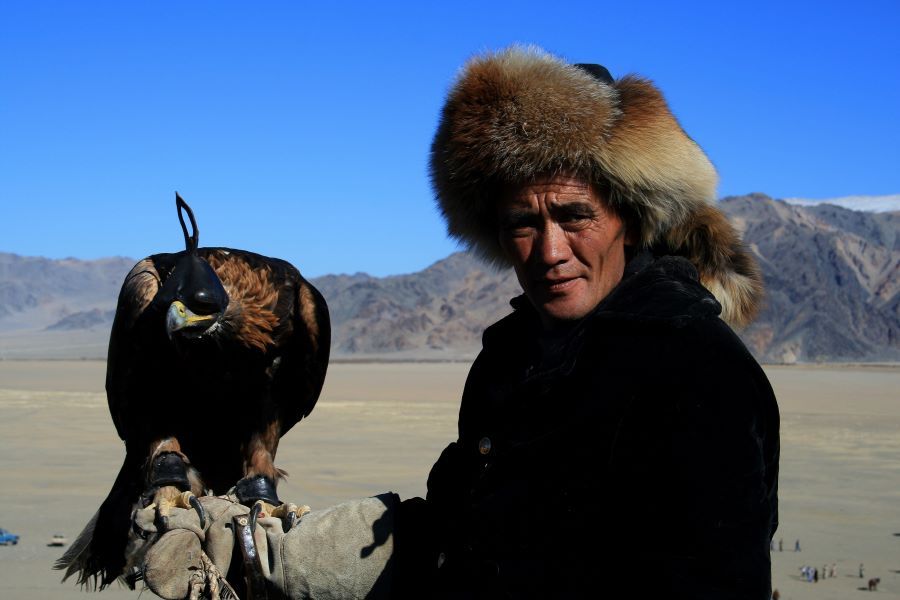
Eagle hunters from around Bayan-Ulgii aimag (province) come to compete in a range of events to test the hunting prowess of their eagles, and to demonstrate their skills at traditional horse games. Between events you can check out unique local crafts laid out on rugs, or sample delicious khuurshuur - deep-fried mutton pancakes.
Everyone dresses up in their best outfits, which are spectacular - even the camels get to wear brightly coloured rugs. There is a general air of chaos with no clear line between contestants and the watching crowd - sometimes you end up closer to the action than you might like!
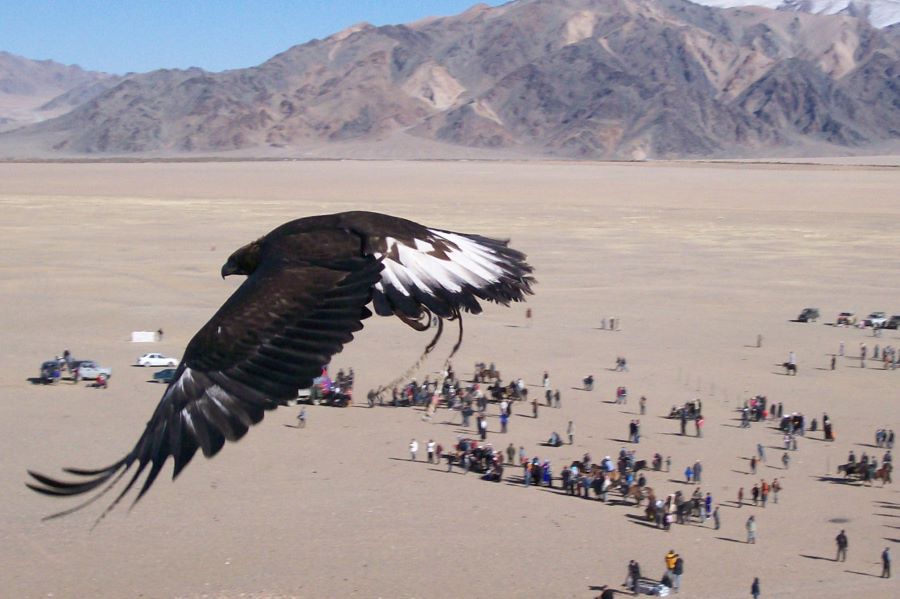
A vital skill in the real world is to be able to call back your eagle after it has been sent out to hunt. To test this, the first event sees the eagle released on a nearby hill-top, from where it swoops down to land on the hunter's arm, homing in on his special call. At least that's the plan. But when half the crowd are also making their own calls, the birds can get quite confused.
To add to the distractions, people in the crowd often wear fox-fur hats, and there's nothing funnier than seeing an eagle decide to hunt one of these 'foxes'. Tip: if it's you wearing that hat, don't run, it will just make the eagle try harder, and the crowd laugh louder.
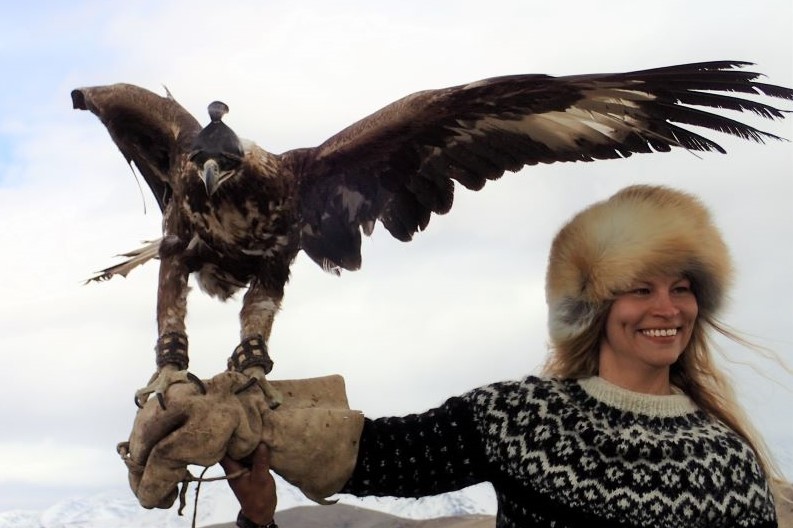
Next comes a test of the eagle's hunting skills. Again the eagle is released from the hill-top, but this time she must grab an animal skin dragged behind the hunter's horse (it's always a she, as female birds are larger and more aggressive). Be ready with your camera, to capture the moment when the eagle plummets out of the sky. You need to be fast, as these birds will attack at up to 130km/hr.
If you consider yourself something of a photographer, you will be in heaven at this festival. There is always some sort of spectacle to point your camera at, whether it's a galloping camel, a majestic eagle, or perhaps just a local kid come to see YOU, the exotic foreign visitor.
Some of the best eagle hunters come from the area where we ride, and are friends of our team, so you will have the opportunity to meet them, and their eagles, personally.
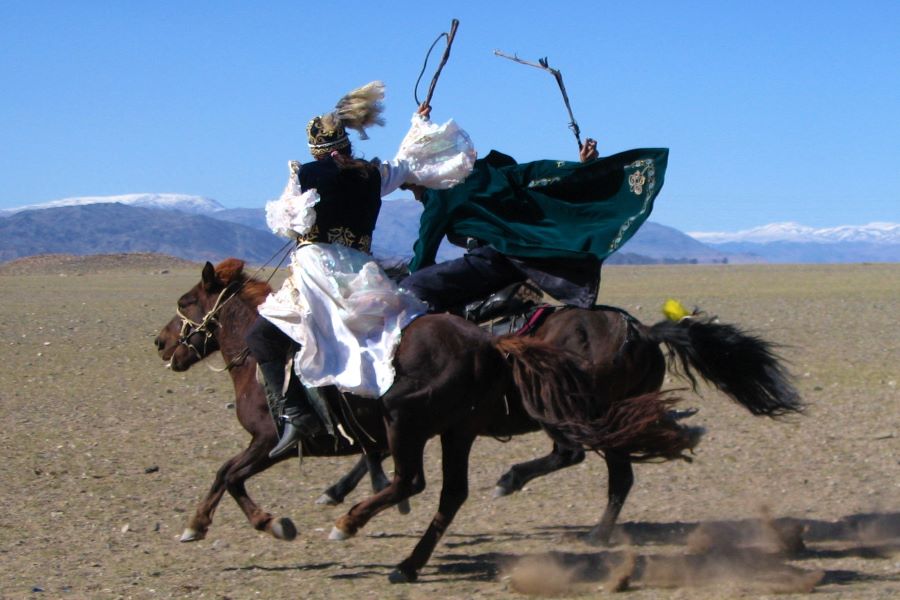
A crowd favourite (amongst the women at least) is Kyz Kuar, the 'race between a man and a woman', in which the woman pursues the man, giving him a good whipping as they gallop across the steppe. It's all about the most stylish whipping, rather than the blows landed, and keeping the two horses close together at a flat-out gallop is no easy thing.
Bushkazi, a tug-of-war with a dead goat involves two riders holding each end of the goat and fighting to gain possession as they gallop randomly about - including into the crowd. Brutal certainly, but a true spectacle, and very fiercely contested. It's quite incredible how far out of the saddle a rider can be pulled without actually falling.
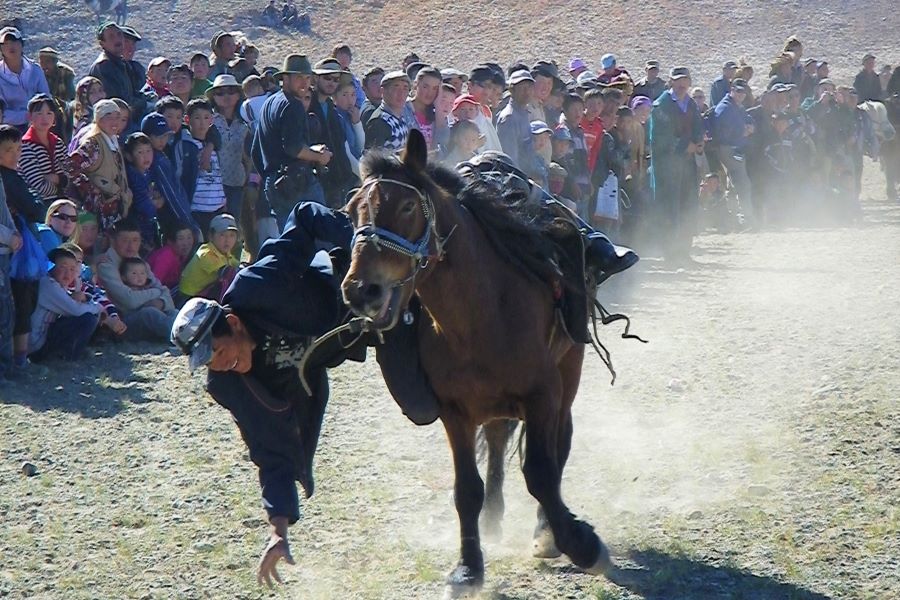
If you are lucky you might get to see the Central Asian version of bushkazi, as played in Kazakhstan, Afghanistan and the other stans of Central Asia. Instead of just two riders and a goat, this involves two teams of riders. The mayhem is multiplied! Keep your wits about you or you're liable to get caught up in the melee.
For a real test of horsemanship, riders lean down out of the saddle at speed to pick up small targets off the ground in the sport of tiyn teru. Very useful when you drop your hat. We don't suggest trying this back home - the horses tend to be so much taller.
Archery from horse-back is another ancient skill on display, and evidently very difficult. Genghis Khan would not have been impressed! In the Mongolia of today it is not a skill in great demand (luckily for us).
As with all our treks, the exact route taken will be weather dependent (for example snow can block the mountain passes). We also like to explore new trails when we have the right group of riders. This Trip Plan (we don't like to use the word itinerary) is an example of the route we may take. Think of our treks as non-itinerised.
| Day | Activities |
| Day 1 | Arrive in Ulaanbaatar. We meet you at the airport/train station and take you to your hotel. You are free to explore this fascinating city before we gather for an evening meal and meet your fellow riders. |
| Day 2 | Fly to Ulgii, the main town of Bayan-Ulgii aimag (province). From here we drive south to reach the edge of Altai Tavan Bogd National Park (4hrs), and meet the horses. We start with a safety briefing and pointers about the local riding style, and then begin matching you to your ideal horse. A ride around the local area in the evening will allow you to decide if this is the horse for you. |
| Day 3 | Set off riding across arid open plains, stopping for lunch with our wrangler Hatran's family at their summer camp along the way. Camp on the shores of Chigertei Nuur, a lovely freshwater lake. |
| Day 4 | Climb up to Jalanash Pass, snow-covered for much of the year, and over into a hidden world of alpine meadows, forests and fast flowing streams. Camp near a pair of ancient khun chuluu, or man-stones, from the Bronze Age. |
| Day 5 | Ride through a military checkpoint and in to the border zone. Keep your passport handy, and your camera lowered. Reach our base camp, beside a fast-flowing mountain stream and nearby forest. |
| Day 6 | A day ride to explore the local area, following game trails up through dense forest to reach alpine grasslands. The views west in to China are spectacular. Keep a watch for elk and ibex. |
| Days 7 to 9 | To explore further we need to load up the packhorses. Follow horse trails used by the border patrol to head down-river, establishing a second base camp for the next two nights. This is remote and spectacular country - Mongolia has a lot of beautiful places, but there is nothing quite like this. We ride up high again, through lush meadows and forest, following narrow game trails. Horse trekking paradise we like to call it! By Day 9 we return to our first base camp, riding high above the river valley this time. |
| Day 10 | A rest day for the horses - it's hard country even for these amazingly tough horses. You may be ready for a rest yourself. Relax and read a book, or go for a hike in search of wildlife. |
| Day 11 | It's now time to start making our way back out of the mountains, via the Pass of Death. It sounds ominous, but that's just the name we gave it when we first came this way many years ago. A series of steep switchbacks drops you down to the valley below. By September, snow is likely. Camp beside Khunt Nuur (Swan Lake). |
| Day 12 | Ride down the valley and over to Shar Gobi Gol (Yellow Gobi River), where we first met the horses right back at the start. We make the most of the wide flat valley to do some fast riding, after all the mountain trails. For those who are keen you will find out just how fast these horses can really go. |
| Day 13 | In the morning we have an informal mini-eagle festival and horse games (see our Altai Mountain trek for details), and then drive back to Ulgii. Stay in a ger camp outside the town, and prepare for the festival. |
| Days 14 to 15 | Attend the Eagle Festival in Tolbo (5th Sept departure), or Ulgii (19th Sept departure). |
| Day 16 | Fly back to Ulaanbaatar. Depending on the flight time, we may be able to see the sites of Ulgii, including the local market, a women's craft cooperative, and the provincial museum. Meet in the evening for our final group dinner and a well-earned drink. |
| Day 17 | We will help with finding any last minute items to take home for friends and family, and if there is time you can see some more of the city. Finally we take you to the airport/train station and say bayartai. |
This map shows the area of Altai Tavan Bogd National Park where we ride, close to the Chinese border.
If you don't see an answer to your question here, please see our general FAQs, or we are happy to have a chat
Everything (almost) is included from the time we meet in Ulaanbaatar on Day 1, until we say farewell on Day 17.
What's not included?
We know you've got common sense, so we don't need to list the obvious exclusions such as visas, travel insurance and your international flights! If in doubt, please ask.
You need to arrive on or before Day 1. The group meets in the evening for our first dinner together, before leaving for the countryside the next day. If necessary, you can arrive late in the evening of Day 1 – missing the first meet-up is not the end of the world. A more serious issue is if you arrive in the evening but your luggage doesn't, leaving little chance to find extra clothing etc before leaving the next day.
If you also get delayed and don't arrive on Day 1, no worries, we will arrange for you to catch up with the group (you won't be the first person to experience that).
Book your return flight for Day 17, or later. We plan to be back in Ulaanbaatar on Day 16.
The Festival treks in September are similar to our earlier treks, but there are two less days in the saddle (you have two days at the festival instead). The planned route is the same. The main focus of the September trips is still the horse trek, but with the added bonus of the festival. If your main aim is just to see the festival, you should talk to us about alternative options.
The other main difference when coming on a September trek is the weather - as Autumn starts, temperatures begin to drop rapidly. You can expect crisp sunny days, but there may be snow too. Camping becomes more challenging. John swears this is the best time to visit the Altai area, as the forests turn golden, the elk are bugling, and fresh snow on the mountains just adds to the beauty of the place!
The main reason is the domestic airline has noticed the increasing number of foreign visitors wanting to fly to Ulgii at festival time, and kindly multiplies the flight price two to three times. Travelling overland is not a great option, with 1700km of hard driving over several days. That eats in to a significant amount of riding time!
It depends whether you prefer your festivals to be large and spectacular with big crowds, or smaller and more intimate. We have been going to both festivals for many years, and enjoy them both - the smaller festival has all the same events as the bigger Ulgii festival, just on a slightly smaller scale. We believe size isn't everything when it comes to festivals.
Both festivals are chaotic, with an itinerary that is quickly forgotten. You do need a sense of humour while trying to figure out what is supposed to be happening. All good fun.
If you are trying to decide which trip to join, you may also wish to think about the weather. If you dislike the cold, the first festival trek is the better option. Even just a couple of weeks can be enough for the temperatures to have dropped significantly. Or you can look at it as an excuse to buy a cool fur hat (we're not big on fur ourselves, but at least here the foxes are free-range).
That's a tricky one. An eagle taking a fox is undeniably brutal, and just because something is traditional (and also occurs naturally), doesn't mean it should be preserved. Otherwise we'd still have bear-baiting and cock fights. The difference here is that hunting with eagles can be considered to still serve a useful purpose. With temperatures dropping to -40C in winter, fur is not just a luxury.
Foxes are not endangered here, but we have certainly seen 'by-catch' of species that should definitely not be hunted, such as Pallas's cat. At the festivals there is no live prey involved, although this has happened occasionally in the past.
Taking golden eagles from the wild, as is traditional practice, can also be questioned, although they are released back to the wild eventually.
Our Altai Mountains and Eagle Festival treks always book out quickly, so if you think this might just be the trip for you, contact us now so we can pencil you in and save a horse for you.